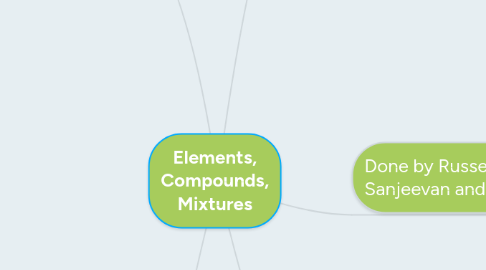
1. Elements
1.1. Pure Substance that cannot be split up into 2 or more simpler substances by chemical processes or electricity
1.1.1. Chemical Symbols used to represent them: e.g. Ca for calcium, Hg for mercury, O for oxygen
1.1.1.1. 2 distinct groups: Metals and Non-Metals, differences include metal being lustrous with a shiny appearance, while solid non-metals have a dull appearance; metals are good conductors of heat, non-metals are mostly poor conductors of heat
1.2. Smallest particle with chemical properties of that element - Atom
1.2.1. Elements that exist as a single atom: Monoatomic e.g. helium, neon, krypton
1.2.2. Molecule: group of 2 or more atoms chemically combined; 2 atoms - diatomic molecule; 3 atoms - triatomic molecule; 4 or more atoms - polyatomic molecules
2. Mixtures
2.1. Formed when 2 or more substances (elements and/or compounds) are added together without chemical bonds being formed
2.1.1. Ratio is not fixed
2.1.2. Can be: Mixture of 2 elements, mixture of 2 compounds or mixture of element and compound
2.1.3. Alloy: mixture of metals with other elements, usually metals. Widely used because they are stronger than pure metals and have similar chemical properties to base elements but different physical properties
2.2. Physically combined in any ratio
3. Compounds
3.1. Pure substance made of two or more elements chemically combined in a fixed ratio
3.1.1. E.g. Ratio of hydrogen to oxygen in water is always 2:1
3.1.2. Naming rules
3.1.2.1. Compounds made of two elements end with -ide e.g. sodium chloride, zinc oxide
3.1.2.2. Compounds that contain hydroxide ions are called hydroxides e.g. potassium hydroxide
3.1.2.3. Compounds containing negatively charged polyatomic ions with oxygen usually ends with -ate e.g. copper sulfate, sodium nitrate
3.1.3. General Rules
3.1.3.1. 1. For many compounds with metallic and non-metallic elements, metallic element's symbol is first e.g. calcium oxide
3.1.3.2. 2. Number of atoms is written as subscript to the right of the atom's symbol
3.1.3.3. 3. Unnecessary to write subscript '1'
3.1.3.4. 4. Oxygen atom is usually at end of formula
3.1.3.5. 5. Subscripts of each element cannot be changed and must be clearly denoted due to drastic changes in a compound's properties if it's element's subscript changes
3.1.4. Physical & Chemical properties of compound very different from constituent elements e.g. sodium, a soft, silvery metal which reacts vigorously with water, reacts with chlorine, a greenish-yellow poisonous gas, to profuce sodium chloride, a white, edible solid which dissolves very well in water
3.1.5. Separation Methods
3.1.5.1. 1. Thermal decomposition e.g. mercury (II) oxide breaks down into mercury and oxygen after being heated
3.1.5.2. 2. Electrolysis e.g. Water is broken down into hydrogen and oxygen through electrolysis
3.1.5.3. 3, Light e.g. Photographic films where silver bromide id broken down into silver and bromine
